
UNCERTAINTY from Williamson Gallery on Vimeo.
Exhibition: UNCERTAINTY (2016)
Curated by Stephen Nowlin
Annotated video browses the full exhibition and installation. ADJUST VOLUME ON.
UNCERTAINTY the exhibition puzzles over the meaning of uncertainty in science, art, and common usage. Artifacts drawn from the domains of both art and science celebrate ambiguity as a wellspring of curiosity and the spirit of exploration, and probe the emotional dimensions of rational inquiry.
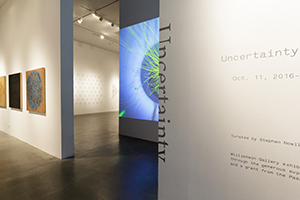
Exhibition: UNCERTAINTY (2016)
Curated by Stephen Nowlin
Thomas McCauley (for the CMS Collaboration), Higgs Boson Candidate Event (8 TeV), 2012; Projected video, dimensions variable. © Courtesy/copyright CERN, for the benefit of the CMS Collaboration. Left of entry: Owen Schuh (with Satyan Devadoss), Cartography of Tree Space (unfolded), 2015; Acrylic, graphite, watercolor, and metal leaf on panel, 108x108 cmm Courtesy of ART 3 Gallery, New York. Photo: Juan Posada/ArtCenter College of Design
More info @: UNCERTAINTY Website
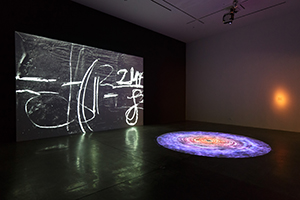
Exhibition: UNCERTAINTY (2016)
Curated by Stephen Nowlin
The Einstein Collective (Christopher O'Leary), Animation for Black (W)hole, 2011 Digital animation, 12 foot diameter floor projection; Courtesy of the artist. Photo: Juan Posada/ArtCenter College of Design
Black Hole Animation is a floor projection in which the viewer enters a laser field of stars and stands on the edge of a black hole accretion disk, which swirls into a supermassive black hole in Newtonian trajectories. The point of view zooms in to the edge of the black hole as a much smaller one is captured and begins to spin around the larger one. Black Hole Animation was created as part of the larger installation Black (W)hole, by The Einstein Collective, made up of artists and scientists that include: Sara Mast, lead visual artist; Jessica Jellison, architect; Christopher O'Leary, animator and visual artist; Cindy Stillwell, filmmaker; Jason Bolte, composer/sound artist; Charles Kankelborg, solar physicist; Nico Yunes, astrophysicist; Joey Shapiro Key, astrophysicist. blackwhole.montana.edu
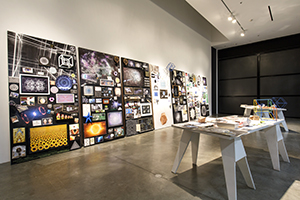
Exhibition: UNCERTAINTY (2016)
Curated by Stephen Nowlin
Marc Fichou, Panels, 2016; Mixed media assemblage, 48 x 96 x 2 inches; Courtesy of the artist. Photo: Juan Posada/ArtCenter College of Design
The work of Marc Fichou provides a link to 18th century cabinets of curiosity, scanning connections in Nature's morphologies and geometries that tantalizing connections, uncertaintie,s and possibilities. His notebooks and objects ponder Nature's apparent alchemy and campaign for deeper knowledge — the essence of uncertainty at work.
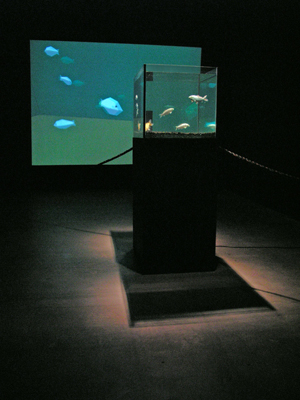
Exhibition: NEURO (2003)
Curated by Stephen Nowlin
Ken Goldberg, Pietro Perona, Infiltrate. Photo credit: Steven A. Heller/ArtCenter College of Design.
Infiltrate was a tank of five Koi fish, surrounded by custom tracking electronics that synthesized and projected the visual perspective of one of the fish, in real time, and allowed spectators to view the tank (and nature) from the inside looking out.
NEURO brought together six contemporary artists with the knowledge and technology resources of the Center for Neuromorphic Systems Engineering (CNSE), at Caltech. Primary project partners at Caltech included Pietro Perona, Jill Andrews, and Peter Mendenhall. CNSE studies how biological organisms sense and make sense of the world, and designs smart machines. Five of the resulting art installations debuted at the Williamson Gallery, and one at Caltech. The exhibition was accompanied by a 60-page illustrated catalogue with essays.
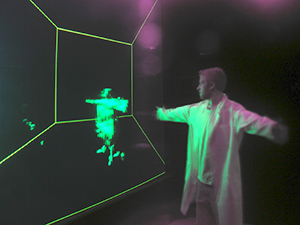
Exhibition: NEURO (2003)
Curated by Stephen Nowlin
Malcolm MacIver, Simon Penny, Body Electric, 2003; Computers, projectors, speakers, infrared lights, cameras, custom software. Photo credit: Steven A. Heller/ArtCenter College of Design.
Body Electric combined active sensing in interactive cultural experience with the study of such systems in neuroscience. In Body Electric, the electrosensory system of weakly electric fish was simulated through a custom multimodal real-time sensing and display system. The 'spectactor' engages in a complex sensorimotoric exploration of a novel environment.
Collaborating individuals include: Andre Bernhardt, Cina Hazegh, Andrew Homyk, Gopi Meenakshisundaram, Zoran Nenadic, Renato Pajarola, Jeffrey Ridenour, Matthieu Triolaire, Patricio Vela.
More info @ NEURO Website: williamsongallery.net/neuro
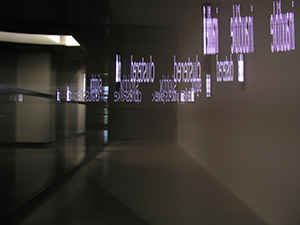
Exhibition: NEURO (2003)
Curated by Stephen Nowlin
Jessica Bronson: perpetual perceptual (about a rose), 2003; Lightsticks, custom software. Photo credit: Steven A. Heller/ArtCenter College of Design.
Bronson's research and installation employed a phenomenon referred to as "retinal painting." Referencing conceptual art practices of the 1960's and 1970's, Bronson's lightstick installation is also inspired by Gertrude Stein's experimental writing. Just as Stein often attempted to describe something without naming it, Bronson similarly attempts to represent a rose through a series of fleeting and impressionistic words.
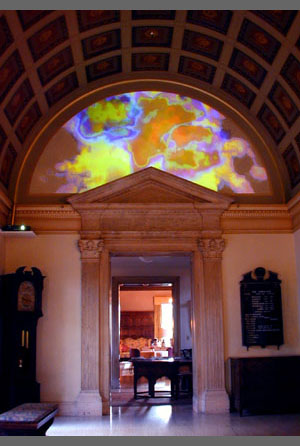
Exhibition: NEURO (2003)
Curated by Stephen Nowlin
Installed in the Athenaeum foyer, California Institute of Technology (Caltech).
Jennifer Steinkamp: Einstein's Dilemma, 2003; Computers, projectors, sensors, Maya, Director, and EZ10 software. Photo credit: Steven A. Heller/ArtCenter College of Design.
At Caltech, scientists and thinkers would pass though the Athenaeum dining hall foyer, perhaps themselves incubating new and revolutionary ideas, and contribute to the cacophony of explosions in Steinkamp's installation. Sensors in the walls above trigger those explosions as individuals pass below. Conceived during the US Gulf War 2, Steinkamp's installation commented on the challenges and disruptions of science and technology, from exquisite possibilities and hope for the future to their part in horrible wars and ecological destruction.
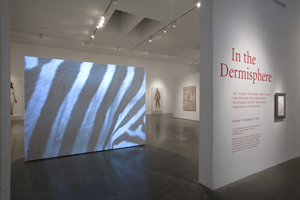
Exhibition: In the Dermisphere (2007)
Curated by Stephen Nowlin
Installation View, contemporary art and the science of skin. Photo credit: Steven A. Heller/Art Center College of Design.
In the Dermisphere included works of art by Aziz + Cucher, Kent Anderson Butler, Carlee Fernandez, Tom Knechtel, Peter Liashkov, Bruce Nauman, Pat York; artifacts from the collections of the Natural History Museum of Los Angeles, and the Huntington Library; and a catalog essay by Nobel Laureate biologist David Baltimore. Through objects of art and natural history, the exhibition focused on skin's biological nature — at the same time questioning the processes by which humans embed social meaning in parts of their biology that have non-social functions and origins.
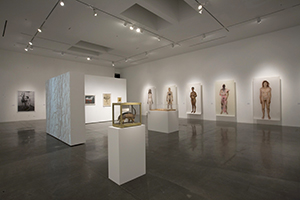
Exhibition: In the Dermisphere (2007)
Curated by Stephen Nowlin
Installation View, Rear: Peter Liashkov, Figures, mixed media on SynSkin. Photo credit: Vahe Alaverdian/Art Center College of Design.
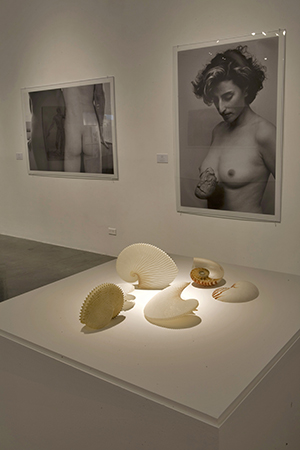
Exhibition: In the Dermisphere (2007)
Curated by Stephen Nowlin
Installation View, Foreground: Nautilus Shells; Background: Photographs by Pat York. Photo credit: Vahe Alaverdian/Art Center College of Design.
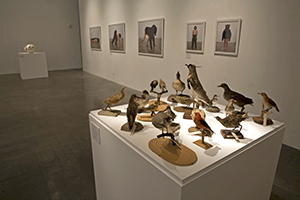
Exhibition: In the Dermisphere (2007)
Curated by Stephen Nowlin
Installation View, Foreground: Taxidermy Birds; Background: Photos, Carlee Sullivan. Photo credit: Vahe Alaverdian/Art Center College of Design.
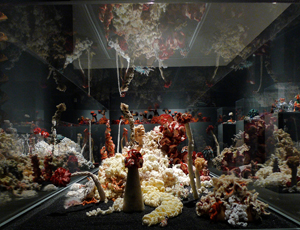
Exhibition: Crochet Coral Reef (Hyperbolic: Reefs, Rubbish and Reason) (2011)
Curated by Margaret and Christine Wertheim
The Cold Water Reef, by the IFF Core Reef Crafters. Photo credit: The Institute for Figuring (IFF).
Created by science writer Margaret Wertheim and her twin sister Christine, Hyperbolic: Reefs, Rubbish and Reason featured crocheted coral facsimiles based upon hyperbolic geometry and served as a meditation on the mystery of mathematics, the evolution of life, the well-spring of human creativity, and the environmental crisis confronting marine ecosystems everywhere. The exhibition was re-designed and expanded for the Williamson Gallery presentation, after appearing at the Smithsonian's National Museum of Natural History.
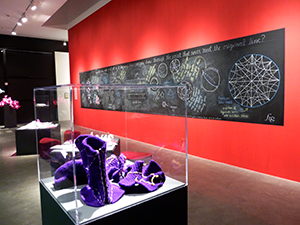
Exhibition: Crochet Coral Reef (Hyperbolic: Reefs, Rubbish and Reason) (2011)
Curated by Margaret and Christine Wertheim
Foreground: Purple Hyperbolic Models by Dr. Daina Taimina. Lines stitched onto the surfaces of these models demonstrate geometric principles of hyperbolic space; Background: Blackboard, drawings and soccer ball model construction by Christina Simons, Cindi Kusuda, Autumn Le Brannon, Daniel Hockenson.

Exhibition: Crochet Coral Reef (Hyperbolic: Reefs, Rubbish and Reason) (2011)
Curated by Margaret and Christine Wertheim
The Toxic Reef, aka Bikini Atoll, Featuring blue plastic anemones made from New York Times wrappers by Clare O'Callaghan, tube worms by Lucinda Ganderton and Christine Wertheim, anemones by Beverly Griffith and Katy Bevan, video-tape kelps by Evelyn Hardin, Julie Ogata and Sarah Simons, white spires by Gina Caciolo, Jelly Yarn kelps by Kathleen Greco, plastic bottle radiolarians and fluffy pink anemone by Orla Breslin.
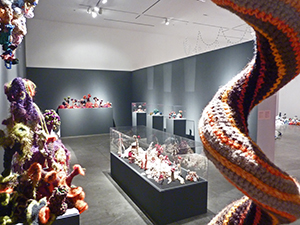
Exhibition: Crochet Coral Reef (Hyperbolic: Reefs, Rubbish and Reason) (2011)
Curated by Margaret and Christine Wertheim
Hyperbolic Sea Snake, (hanging) by Helen Bernasconi.
REALSPACE from Williamson Gallery on Vimeo.
Exhibition: REALSPACE (2014-15)
Curated by Stephen Nowlin
Annotated video browses the full exhibition and installation. ADJUST VOLUME ON.
The exhibition REALSPACE reflected on how science intersects with the history of how pictorial space in art changed under the influence of science. Nineteenth-century art's deconstruction of illusion in pictorial space and its ultimate relocation of aesthetic experience in real space can be viewed as a metaphor for simultaneous changes taking place in the humanities, sciences, and technology. It helped create a cultural Weltanschauung, a world view shaped by the gradual decline of fictional supernatural theories about the world (analogous to paintings depicting things in illusory space) and the rise of scientific ones (analogous to paintings becoming objects themselves in real space). Poeticized by artists and studied by scientists throughout human history, the intractable reality of the natural world was examined through contemporary art and artifacts included in REALSPACE.
More info @ REALSPACE Website: williamsongallery.net/realspace
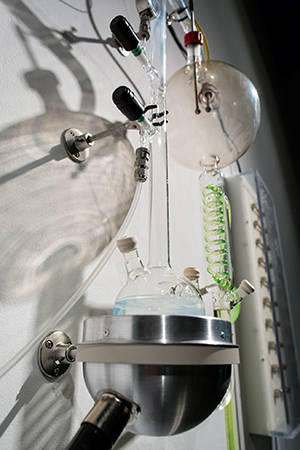
Exhibition: REALSPACE (2014-15)
Curated by Stephen Nowlin
Adam W. Brown, Robert Root-Bernstein, Origins of Life: Experiment #1.x, 2010, Lab beakers, gas canisters, chemicals, electronics, 72 x 120 in., dimensions variable. Photo credit: Rebeca Mendez.
The Origins of Life series is a working performative installation and imagining of the famous experiments carried out by Stanley Miller and Harold Urey at the University of Chicago in the 1950s. Miller-Urey set out to test the hypothesis that by recreating the atmosphere of the early Earth and adding an energy source such as lightning to the mix, the building blocks of life might appear. Within days, the experiment yielded the amino acid glycine, and within a week, alanine and urea as well.
"This Land" series from Williamson Gallery on Vimeo.
Exhibition: REALSPACE (2014-15)
Curated by Stephen Nowlin
Stephen Nowlin, This Land, 2014, Video, 2 min
Left side, Bull Pasture, Organ Pipe Cactus National Monument, Arizona, USA, Earth. Photo: The National Park Service;
Right side, Curiosity Rover at Rocknest, Mars. Photo: NASA/JPL-Caltech/MSSS.
This Land series references the Woody Guthrie song This Land is Your Land, written in 1940 as a critical response to Irving Berlin's God Bless America. Guthrie's song romanced about the American landscape while protesting its privatization and the treatment of Dust Bowl and Depression era refugees. As a tribute to Guthrie's song, This Land series puzzles over the myopic concept of divine blessing and the provinciality of an Earth-bound conception of 'land,' and a reconsideration of what 'our land' means in a solar system full of new worlds. The series is a meditation on how science re-scales our perspectives and disrupts an understanding of where we live, what is ours, and how we fit in.
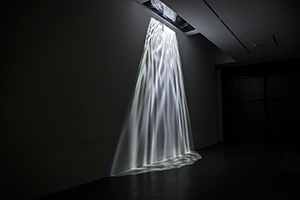
Exhibition: REALSPACE (2014-15)
Curated by Stephen Nowlin
Dan Goods, David Delgado, Refraction, 2014. Theater light, water, custom electronics, 19 x 25 ft., dimensions variable
Refraction is the altering of the direction of a wave due to a change in its transmission medium. In the development of early telescopes, refraction played an important role and occupied the efforts of scientists such as Isaac Newton who were curious about the properties of light. The refracting telescope tamed the physics of bent light by the creation of a lens that caused its rays to converge together upon a focal point. In this exhibition's Refraction installation, the opposite happens — the beauty of untamed waves of light intersecting with rowdy waves of water are allowed their expressive chaos and feral subtleties.
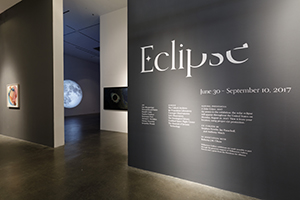
Exhibition: ECLIPSE (2017-18)
Entryway, ECLIPSE exhibit. Photo credit: Juan Posada/ArtCenter College of Design.
Co-curated by Stephen Nowlin (Williamson Gallery Director/Curator), Jay Pasachoff (Field Memorial Professor of Astronomy at Williams College), and Anthony Misch (Director, Lick Observatory Historical Collections Project), in association with New-York Historical Society Curator of Drawings Roberta J.M. Olson, ECLIPSE featured works of contemporary art by Lita Albuquerque, Russell Crotty, Stephen Dankner, Rosemarie Fiore, Michael C. McMillen and Jacqueline Woods, as well as historical paintings by Howard Russell Butler (1856-1934). It further included objects and artifacts borrowed or sourced from the Lick Observatory, The Huntington Library, the Museum of Jurassic Technology, Caltech Archives, JPL/NASA, Carnegie Observatories, and Goddard Space Flight Center.
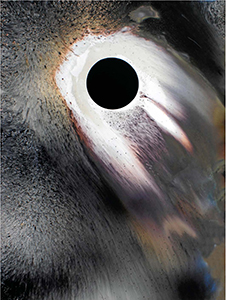
Exhibition: ECLIPSE (2017-18)
Jacqueline Woods, Black Sun with Falling Corona, 2016; Unique Gelatin Silver Print, 40 x 30 inches. Courtesy of Jacqueline Woods.
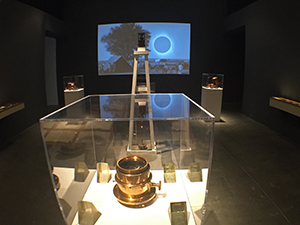
Exhibition: ECLIPSE (2017-18)
Anthony Misch, curator; Lick Observatory Historical Collections, Artifacts and Exhibition Film, 20th century; Courtesy of the University of California Observatories. Photo credit: Stephen Nowlin/ArtCenter College of Design.
More info @ ECLIPSE Website: williamsongallery.net/eclipse
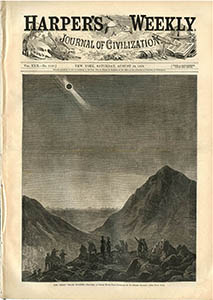
Exhibition: ECLIPSE (2017-18)
Harper's Weekly Cover, August 24, 1878; Collection of Stephen Nowlin.
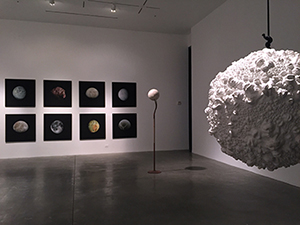
Exhibition: MOONS (2018)
Curated by Stephen Nowlin
Gallery View: Foreground; Tim Hawkinson, Thumbsucker, 2015, Mid: Sarah Perry, Impossible Gift, 2013, Background: Kevin M. Gill, Ten Moons, 2018, photo: Stephen Nowlin/ArtCenter
Artists and sources contributing to MOONS include Alternative Moons (Nadine Schlieper & Robert Pufleb), Carnegie Observatories, Caltech Archives, Kevin Gill, James Griffith, Tim Hawkinson, The Huntington Library, Melanie King, Sarah Perry, Steve Roden, Karley Sullivan, Penelope Umbrico, Mount Wilson Observatory and Jacqueline Woods. "Celestial bodies tethered by orbital physics to our solar system's planets, commonly known as moons, comprise a consortium of enticing worlds that are rocky, wet, icy, cratered, hot, cold, and puzzling, some of whose veneers are textured with mountains, lakes, concealed oceans, valleys, volcanoes, geysers, canyons and plains, and have both water and heat to fuel tantalizing speculations."
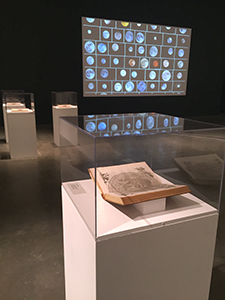
Exhibition: MOONS (2018)
Curated by Stephen Nowlin
Gallery View: Foreground; Johannis Hevelii, Selenographia: A Description of the Movements of the Moon, 1647, Mid; Steve Roden, when stars become words (score), 2007, Background; Penelope Umbrico, Everyone's Moon 2015-11-04 14.22.59, 2015, photo: Stephen Nowlin/ArtCenter
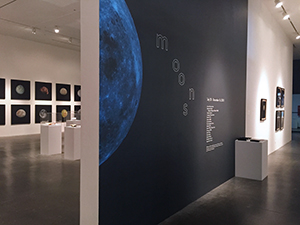
Exhibition: MOONS (2018)
Curated by Stephen Nowlin
Gallery Entry, photo: Stephen Nowlin/ArtCenter
More info @ MOONS Website: williamsongallery.net/moonsexhibit
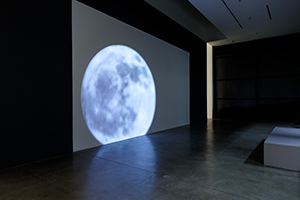
Exhibition: MOONS (2018)
Curated by Stephen Nowlin
Melanie King, Moon Rising, 2016, Digital video, projected; size variable, Courtesy of the artist, photo: Juan Posada/ArtCenter
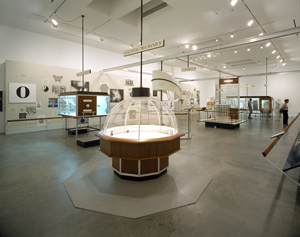
Exhibition: Mathematica: A World of Numbers and Beyond (2000)
Re-assembled for Williamson Gallery exhibition, courtesy of California Science Center and Eames Demitrios. Photo credit: Steven A. Heller/Art Center College of Design.
Charles & Ray Eames' Mathematica: A World of Numbers and Beyond, 1961, was sponsored by the IBM Corporation for the California Museum of Science and Industry (now the California Science Center), where it remained on display until 1998. In 2000 it was reassembled in the Williamson Gallery, July 30 — October 1. It is now owned by and on display at the New York Hall of Science.
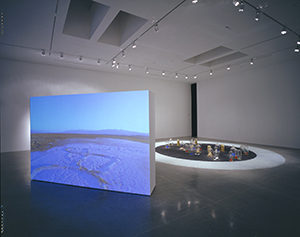
Exhibition: REVERENCE: Poetics and Polemics of Sustainability (2005)
Curated by Stephen Nowlin
Gallery View: Foreground; Jessica Bronson, Panamint Tilt, 2000; Background; Lita Albuquerque, Stellar Mapping I, 2005, photo: Stephen Nowlin/ArtCenter
Reverence was meant to question the human impulse to exist in a symbiotic relationship with nature — an impulse both emotional and intellectual, and which helps nourish what becomes efforts toward a sustainable world. The exhibition included NASA photographs of human impact on the environment; Godfrey Reggio's Anima Mundi, a film with musical score by Phillip Glass focusing on preserving the earth's species, the environment, and their binding relationship; posters on Green issues and environmental action initiatives from the Center for the Study of Political Graphics; Jessica Bronson's Panamint Tilt addressing the Earth as a macroorganism; Lita Albuquerque's Stellar Mapping I charting alignments between earth and sky; a letterpress memorial to every extinct species in the last 100 years by artist/bookmaker Gloria Kondrup; a series of nature photographs by Ansel Adams juxtaposed against a series of toxic dump photographs by Edward Burtynsky, and others.
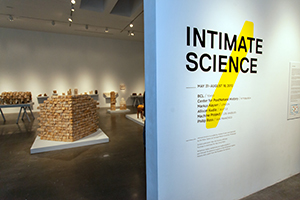
Exhibition: Intimate Science (2013)
Curated by Andrea Glover
Exhibition Installation View, 2013
Intimate Science was curated by Andrea Glover in 2012 for the Miller Gallery at Carnegie Mellon University, and traveled to the Williamson Gallery in 2013. The exhibition featured artists who are engaged in non-disciplinary inquiry; artists who are not allied to the customs of any single field, and therefore have license to reach beyond conventions. This kind of practice hinges on up-close observation, experiential learning, and inventing new ways for the public to participate in the process. And through their engagement with “intimate science,” a more knowledgeable public might well be able to influence what research is supported and adopted by the larger culture, and the walls of science can become more transparent.
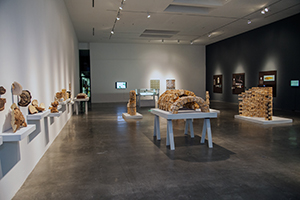
Exhibition: Intimate Science (2013)
Curated by Andrea Glover
Exhibition Installation View, 2013
More info @ Intimate Science Website: millergallery.cfa.cmu.edu
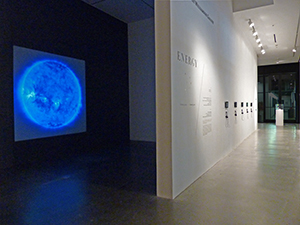
Exhibition: ENERGY (2010)
Curated by Stephen Nowlin
SUN, STEREO spacecraft view, using Extreme UltraViolet Imager (EUVI), revealing ionized iron, June 1 – 30, 2007. Image credit: Solar System Visualization Project, NASA/JPL-Goddard. Photo credit: Steven A. Heller/Art Center College of Design.
The exhibition ENERGY looked at how natural forces shape not only material things, but impact our emotions and intellect as well. The exhibition included works by contemporary artists, mixed with artifacts borrowed from: the Division of Geological and Planetary Sciences, Caltech; The Huntington Library; NASA/JPL/Goddard Solar System Visualization Project; DAWN space mission, JPL/Caltech; Institute of Geophysics and Planetary Physics, UCLA. The installation photo shows a rear-screen projection of 1-year sun rotation.
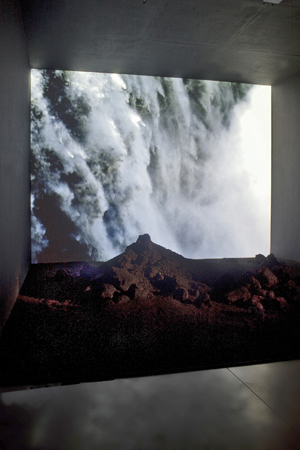
Exhibition: ENERGY (2010)
Curated by Stephen Nowlin
Rebeca Mèndez, At Any Given Moment, Fall 1, with Volcanic Rock, 2009. Video projection and installation. Photo credit: Steven A. Heller/Art Center College of Design.
The exhibition ENERGY looked at how natural forces shape not only material things, but impact our emotions and intellect as well. The exhibition included works by contemporary artists, mixed with artifacts borrowed from: the Division of Geological and Planetary Sciences, Caltech; The Huntington Library; NASA/JPL/Goddard Solar System Visualization Project; DAWN space mission, JPL/Caltech; Institute of Geophysics and Planetary Physics, UCLA.
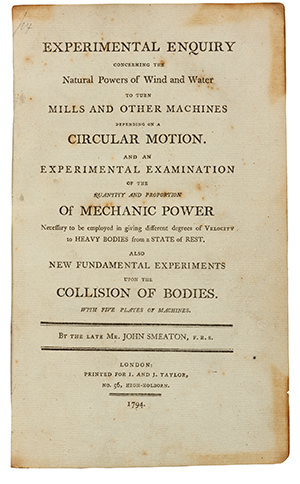
Exhibition: ENERGY (2010)
Curated by Stephen Nowlin
John Smeaton, Experimental Enquiry, 1794. Courtesy of The Huntington Library, San Marino, California.
The exhibition ENERGY looked at how natural forces shape not only material things, but impact our emotions and intellect as well. The exhibition included works by contemporary artists, mixed with artifacts borrowed from: the Division of Geological and Planetary Sciences, Caltech; The Huntington Library; NASA/JPL/Goddard Solar System Visualization Project; DAWN space mission, JPL/Caltech; Institute of Geophysics and Planetary Physics, UCLA.
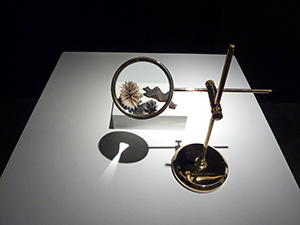
Exhibition: ENERGY (2010)
Curated by Stephen Nowlin
Foreground: Deep Sea Corals, Solar energy-dependent Madrepora occulata and Desmophyllum dianthus coral skeletons collected from approximately one mile deep. Existing far below the ocean surface, the livelihood of these corals begins with sun energy at the surface and travels down through the food chain to the dark regions below. Courtesy of Jess Adkins, Division of Geological and Planetary Sciences, Caltech
More info @ ENERGY Website: williamsongallery.net/energy
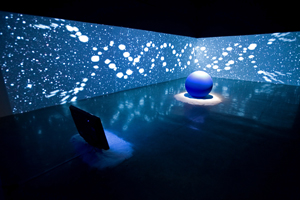
Exhibition: OBSERVE (2008)
Curated by Stephen Nowlin
Lita Albuquerque, Stellar Suspension, 2008. Photo credit: Steven A. Heller/Art Center College of Design.
Like an ancient explorer of the night sky, Lita Albuquerque looks for alignments -- suggestions of relationships appealing not only to intellectual curiosity but also that resonate with deep emotional content. In a reversal of the astronomer's gaze outward, her installation incorporates projected images of stars mapped onto the surface of the earth -- the earth as a subject of the stars' curiosity, rather than vice-versa. Stellar Suspension is a metaphor for our evolving and mysterious relationship with the cosmos.
Exhibition: OBSERVE (2008)
Curated by Stephen Nowlin
Video browses the full exhibition and installation. ADJUST VOLUME ON.
The exhibition OBSERVE included five contemporary artists that were invited to consult and collaborate with scientists at Caltech's Spitzer Science Center, home of the infrared sun-orbiting NASA Spitzer Space Telescope — Lita Albuquerque. Lynn Aldrich, Dan Goods, George Legrady, and Daniel Wheeler. The artists' installations in the Williamson Gallery were inspired by conversations surrounding the practice, discoveries, theories, and speculations of deep-space astronomy. The exhibition was accompanied by a 75-page illustrated catalogue with essays.
More info @ OBSERVE Website: observeexhibit.org
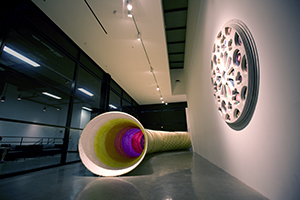
Exhibition: OBSERVE (2008)
Curated by Stephen Nowlin
Lynn Aldrich, Pilgrimage (Through the Wormhole), 2008; drywall panels, cardboard construction tubes, fake fur, bulletin board, collected images, materials, and documents. Courtesy of the Artist and Carl Berg Gallery.
Pilgrimage (Through the Wormhole) is a physical passage through one metaphorical dimension of perception to another. Via surveys submitted to the Spitzer scientists, the artist asked them questions about how the emotional and spiritual impact of their work relates to the intellectual rewards of accomplishing science. Her installation incorporates scientists' responses as visitors traverse the wormhole from one space in the gallery to another.

Exhibition: OBSERVE (2008)
Curated by Stephen Nowlin
George Legrady, We Are Stardust, 2008; Multimedia 2 screen projection installation with infrared camera. Courtesy Edward Cella Gallery.
Based on the angles of views of the sun-orbiting Spitzer telescope since its launch in 2003, We Are Stardust consists of sky constellations and markings of space locations were Spitzer scientists have been collecting data. A fully rotational ceiling-mounted infrared camera retraces angular positioning of the Spitzer telescope, and features what the camera is seeing in the exhibition space.
PAGES from Williamson Gallery on Vimeo.
Exhibition: PAGES (2012)
Co-curated by Stephen Nowlin and John David O'Brien.
Video browses the full exhibition and installation. ADJUST VOLUME ON.
PAGES was one of a decade-long series of Williamson Gallery exhibitions that superimpose art, science, literature, and history. It included contemporary art, sculpture, books, and orphaned pages from history. Artifacts and objects in the exhibition were drawn from artists’ studios, as well as major repositories of books and pages including The Huntington Library, Albert Einstein Archives at the Hebrew University of Jerusalem, Doheny Library at the University of Southern California, The Caltech Archives, and private collections. Artists in the exhibition included Cara Barer, Hans Burkhardt, Steven Cortright, Claire Falkenstein, Suvan Geer Alexandra Grant, Simon Johnston, Gloria Kondrup, Robert Kushner, Andrew Leicester, Peter Liashkov, Michael C. McMillen, Rebeca Mendez, Heidrun Mumper-Drumm, George Nama, Echiko Ohira, Pierre Picot, Harry Reese, Victor Rosas, Ed Ruscha, Owen Schuh, and Susan Sironi.
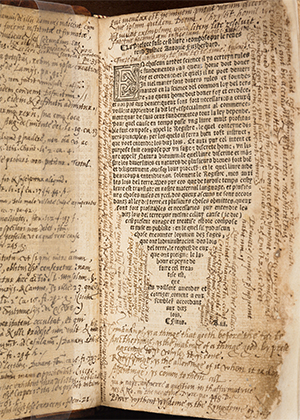
Exhibition: PAGES (2012)
Co-curated by Stephen Nowlin and John David O'Brien.
Anthony Fitzherbert, La Novelle Natura Brevium, 1534. Book with marginalia; Courtesy of the Huntington Library.
La Novelle Natura Brevium (1534) was a treatise on English law by Anthony Fitzherbert. It is often cited in judgments today across the common law world, and represents an important tract on the rules of common law in the 16th century
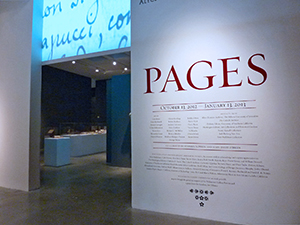
Exhibition: PAGES (2012)
Co-curated by Stephen Nowlin and John David O'Brien.
Gallery entry.
More info @ PAGES Website: williamsongallery.net/pages
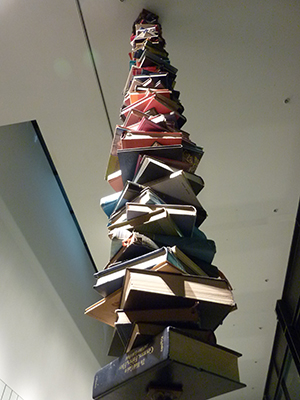
Exhibition: PAGES (2012)
Co-curated by Stephen Nowlin and John David O'Brien.
Michael C. McMillen, Delilah II, 1991 (reconstructed 2012), Mixed media installation. Courtesy of the artist and L.A. Louver, Venice, CA.
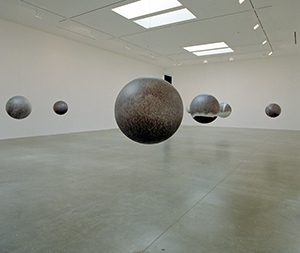
Exhibition: Russell Crotty: The Universe from My Backyard (2001)
Curated by Stephen Nowlin.
Installation View: hanging globes, ink drawings of celestial phenomena.
Via a contemporary sensibility, Crotty invokes the ancient pastime of observing stars in the night sky and generating drawings and sketches of what he sees from his private observatory. The results of his explorations resonate on the boundary between art and science. Crotty's cosmic diagrams, ink renderings, and books speak to the contemporary impact of science on our lives. At the same time, they carry on a romance with the notion that tiny human life forms will go out of their way to contemplate an utterly vast universe
More info @ The Universe Festival 2001, archived website.
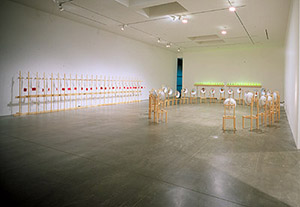
Exhibition: Resonant Messages: Media Installations by Paul DeMarinis (2000)
Co-curated by Stephen Nowlin and Erkki Huhtamo.
Installation view of The Messenger, 1998, consisting of enameled steel bowls, electromagnets, wooden chairs, toy skeletons, burlap, wood, glass jars, metal foil electrodes, electrolyte, computer, electronics, and internet connection.
Paul DeMarinis has been working as a multimedia electronic artist since 1971 and has created numerous performance works, sound and computer installations and interactive electronic inventions. He has performed internationally, at The Kitchen, Festival d'Automne a Paris, Het Apollohuis in Holland and at Ars Electronica in Linz and created music for Merce Cunningham Dance Co. His interactive audio artworks have been shown at the I.C.C. in Tokyo, Bravin Post Lee Gallery in New York and The Museum of Modern Art in San Francisco. He has been an Artist-in-Residence at The Exploratorium and at Xerox PARC and has received major awards and fellowships in both Visual Arts and Music from The National Endowment for the Arts and the John Simon Guggenheim Foundation.
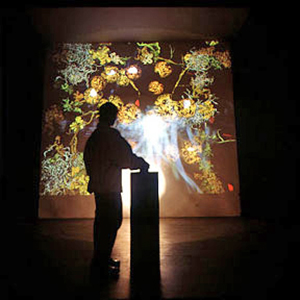
Exhibition: Digital Mediations (1995)
Co-curated by Stephen Nowlin and Erkki Huhtamo.
Christa Sommerer and Laurent Mignonneau, Phototropy, 1994
Dutch pharmacist and zoologist Albertus Seba (1665-1736), produced a multi-volume record of his eighteenth century cabinet of natural history specimens, commissioning artists to illustrate his vast collection. The PAGES exhibition looked at "the page" as a space for expressing and wrestling with ideas, and superimposed the domains of art, science, history, and literature.
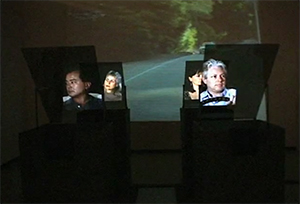
Exhibition: Physical Fiction, Interactive Media Installations by Sara Roberts (1998)
Curated by Stephen Nowlin.
Sarah Roberts, Elective Affinities, 1994; 4 monitor cases, custom built electronics,4 Macintosh 660AV, ethernet, speakers, 5 Laserdiscs, 4 video monitors, video projector. Engineering by Palle Henckel.
Sara Roberts and a few others are laying out the topography of a genuine new visual style. This artistic landscape is cultivated by artists comfortable with a palette of computer software, sleek programmable electronic boxes, and an engaging interactivity with their audience -- the latter necessary to ignite the art moment. It is also somewhat familiar terrain, informed by the temporal possibilities of video and the object awareness of sculpture. -- Nowlin, 1998
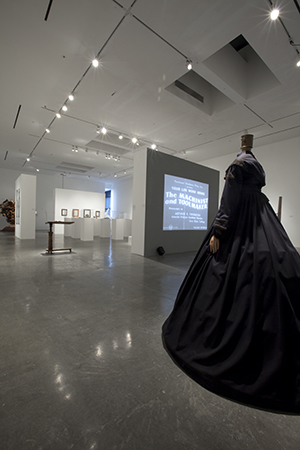
Exhibition: TOOLS (2009)
Co-curated by Stephen Nowlin and John David O'Brien.
Installation View: Stephen Berkman: Obscura Object; Film, The Machinist and Tool Maker, 1942
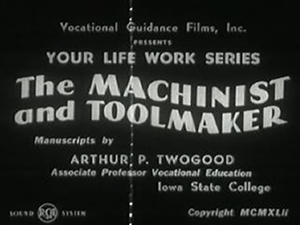
Exhibition: TOOLS (2009)
Co-curated by Stephen Nowlin and John David O'Brien.
The origin for all human tools is found at the outer limits of our evolved biology -- the length of our arms, the coefficient of propulsion available through our leg muscles, or the rotational range of our eyes. For millenia, tools have transcended these biological limits and played a role in human evolution. An undeniable part of the beauty of tools is that they don’t try to be beautiful – instead they try to solve problems effectively and when they do, then they become beautiful in some odd way that nobody really understands.
Artists contributing to TOOLS included Janine Antoni, Stephen Berkman, Robert Hudson, Ben Jackel, Nancy Kyes, Tom LaDuke, Michael McMillen, John Millei, Mark Niblock-Smith, Russell W. Porter, Paul Tzanetopoulos, and Gail Wight. NASA/JPL engineer Tom Rivellini is represented by sketches that led to the successful Mars Pathfinder landing in 1997 – a remote-sensing tool. In addition to the Autry Center and Carnegie Institution, organizations lending artifacts to TOOLS included Bolt’s Antique Tool Museum in Oroville, CA, California Institute of Technology, The Huntington Library, and Jet Propulsion Laboratory, as well as private lenders.
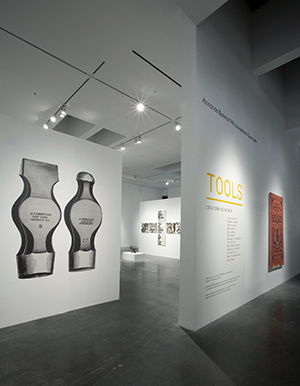
Exhibition: TOOLS (2009)
Co-curated by Stephen Nowlin and John David O'Brien.
Installation view: gallery entry.
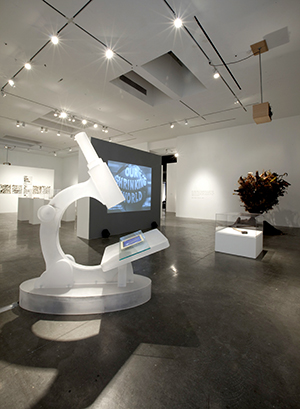
Exhibition: TOOLS (2009)
Co-curated by Stephen Nowlin and John David O'Brien.
Foreground: Gail Wight, Meaning of Minuscule, 2007; Plexiglas, software, LCD screen, interactive electronics, audio. Right: Nancy Kyes, PLOW (the border between two orders)>, 1997; mixed media.
WORLDS from Williamson Gallery on Vimeo.
Exhibition: WORLDS (2011)
Curated by Stephen Nowlin
Annotated video browses the full exhibition and installation. ADJUST VOLUME ON.
The exhibition WORLDS included contemporary art, sculpture, video, sound, and large-scale installations by New York artists Richard Selesnick and Nicholas Kahn, the London artist team "semiconductor," photographer Darin Boville, and artists Jonathan Cecil, Michael C. McMillen, Rebeca Mendez, and Steve Roden, as well as data visualizations by British animator Adrian Lark, NASA HiRise Mars altimeter imagery, NASA spacecraft imagery, meteorites, vintage science fiction video, and astronomical book sketches by Galileo Galilei and Nicolaus Copernicus, drawn from the rare-book collection of the Huntington Library.
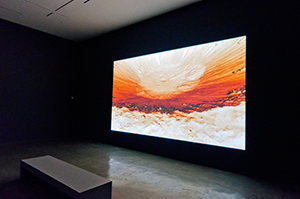
Exhibition: WORLDS (2011)
Curated by Stephen Nowlin
Adrian Lark, Zumba Crater, Mars, 2010-2011
Motion visualization, using NASA Mars Reconnaissance Orbiter HiRise and Laser Altimeter data.
For millennia astronomers have been gazing at Mars, and current humans are the first in that long history who are privileged to see it up close. This video excursion into an impact crater on Mars is an entirely data-driven view, nothing is invented. Every rock is a real rock resting on the surface of the red planet. The WORLDS exhibition explored the shift in awareness we Earth-bound humans are undergoing, as a result of discovering through science and technology both the wonders of our cosmic neighborhood and the similarities they share with our home planet.
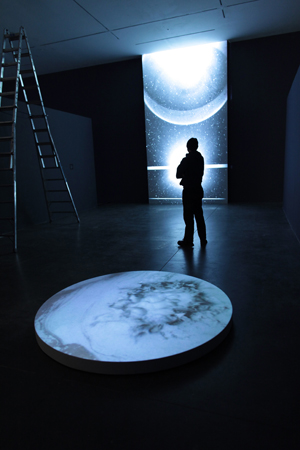
Exhibition: WORLDS (2011)
Curated by Stephen Nowlin
Rebeca Mendez, Quagmire, 2011 (foreground); Semiconductor, Black Rain, 2009 (background - NASA STEREO spacecraft video). Photo credit: Adam Eeuwens.
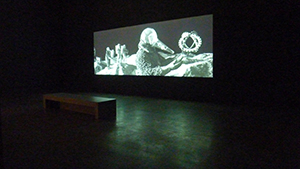
Exhibition: WORLDS (2011)
Curated by Stephen Nowlin
Nicholas Kahn and Richard Selesnick, Liftoff, from the Apollo Prophecies,, 2002-2006; digital imagery, constructed model, photography
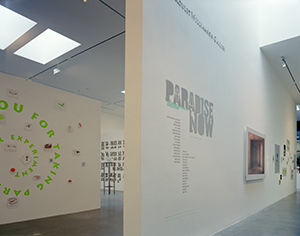
Exhibition: Paradise Now: Picturing the Genetic Revolution (2003)
Co-curated by Marvin Heiferman and Carole Kismaric.
Gallery entry, background: Christy Rupp, New labels for Genetically Engineered Food, 1999-2000; mixed-media wall installation.
Organized by Exit Art in New York City and co-curated by Marvin Heiferman and Carole Kismaric, "PARADISE NOW: Picturing the Genetic Revolution" places focus on the political, social and cultural ramifications of the often monocular vision of science. Art more often than not expresses the unique viewpoint of an unconverted, unaligned, and, generally, iconoclastic segment of our society. The work in this exhibition is no exception. Each artist scrutinizes and questions the profound shifts in our basic understanding and acceptance of nature's (formerly) incontrovertible truths that genetic engineering brings to the table.
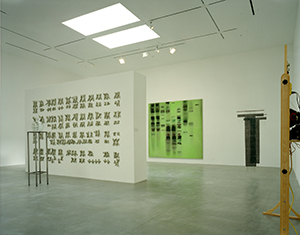
Exhibition: Paradise Now: Picturing the Genetic Revolution (2003)
Co-curated by Marvin Heiferman and Carole Kismaric.
Foreground wall: Suzanne Anker, Zoosemiotics (Primates), 1993; Rear left: Dennis Ashbaugh, Bio-Gel (AKA The Jolly Green Giant), 1990-91; Rear right: Christine Davis, ACGT I and II, 1998-99.
Society is at a threshold, witnesses to the moment when genetic research is rewriting the definition of life. Biotechnology is altering the food we eat, and the information revealed by the decoding of the human genome will give science, medicine, and business unprecedented power. Increasingly, the news media and popular culture are alerting the public to the heated dialogue that is underway about what out brave new world might become. Daily, the unusual procedures and outrageous prediction that were once the subject of science fiction are announced as realities. Each new announcement triggers hope and controversy and guarantees further debate among humanitarians, profit seekers, legal experts, ethicists, politicians, nations, and the public.
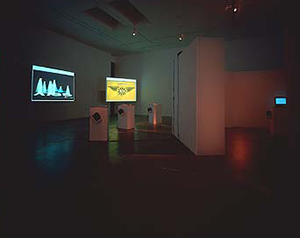
Exhibition: img src (Image Source) (2000)
Curated by Stephen Nowlin.
Installation view, interactive internet viewing stations.
From the beginning, net-artists saw themselves as a kind of rebel movement, confronting both the hard and soft-ware world of corporate start-ups and dizzying techno-growth, as well as the entrenched world of a gallery/museum complex that reigns over "traditional" contemporary art. Hyper-Text Markup Language (HTML) had liberated them, enabled them to become free-wheeling cultural taggers -- urban roving art-techs. They'd discovered the genie's lamp of artistic freedom - the ability to self-publish, to reach an audience without need of intermediary galleries, museums, critics, funding agencies, or expensive tubes of cadmium red. Artists and sites included Superbad, Natalie Bookchin, Sabin Daley, Kristin Lucas, Gary Simmons, Jens Schmidt, Peter M. Traub.
More info @ the img src archived website.
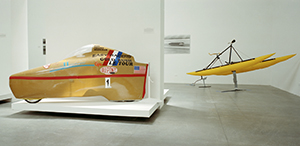
Exhibition: Anthropropulsion (1996)
Co-curated by Stephen Nowlin and William Gaines.
Installation view.
The investigation into applications of human power is more that just an engineer's tinkering or enthusiast's hobby. It expresses a way of seeing human beings in relationhip to their natural environment. It is innately optimistic, showing that by combining science, technology, ecological awareness and human ingenuity, we can strengthen our alliance with the Earth. Among the vehicles displayed in Anthropropulsion are the Flying Fish, a human-powered hydrofoil that "flys" on water (pictured, right); a replica of the Gossamer Albatross, the first human-powered aircraft to cross the English Channel; and the Gold Rush Le Tour (pictured, left), the first human-powered land vehicle to exceed 65 miles-per-hour.
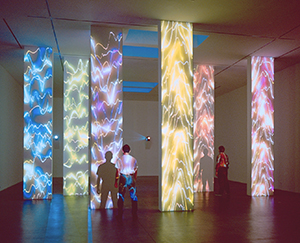
Exhibition: STIFFS by Jennifer Steinkam; and Jimmy Johnson (2000)
Curated by Stephen Nowlin.
Installation View: STIFFS, 2000, site-specific installation for the Williamson Gallery; custom software, computers, projectors, speakers, sensors.
Jennifer Steinkamp uses computer-generated imagery to blur the boundaries between real and virtual space. Her projected light dematerializes architecture by placing an illusionistic space inside a real space. By imaging the geometric space of the computer and remaping it with projection, she creates an in-between space, a space between virtual and real. STIFFS launched the Williamson Gallery series of exhibitions observing the convergence of art and technology, "alongside a co-theme converging art and science." Wrote curator Stephen Nowlin at the time: "Technology and science are not the same exactly, but the former implies the omniscience of and reliance upon the latter, and art that uses technology cannot help but to suggest that scientific progress, to a greater and greater degree, will frame the 21st century’s artistic dialectic."
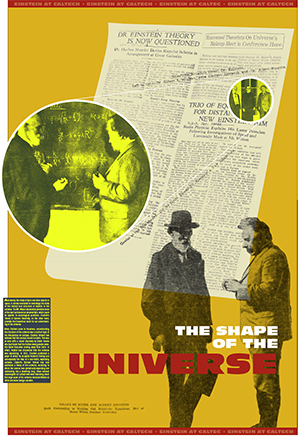
Exhibition: Einstein at Caltech Mobile Exhibit (2005)
Co-curated by Diana Buchwald and Stephen Nowlin; Graphics by Carla Figueroa.
The Shape of the Universe; one of nine printed visuals to document Einstein contributions to physics.
The year 2005 was named the World Year of Physics, also known as Einstein Year, in recognition of the 100th anniversary of Albert Einstein's "Miracle Year", in which he published four landmark papers, and the subsequent advances in the field of physics. To celebrate, Caltech developed a mobile exhibit highlighting Einstein's visits to the Pasadena campus.
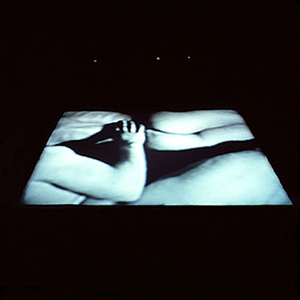
Exhibition: Memory, Recollection, and Transformation, Reactive Works by Jim Campbell (1997)
Curated by Stephen Nowlin.
Untitled (for Heisenberg), 1995; ultrasonic sensors, salt, laserdisc player, custom electronics.
Born in Chicago in 1956, San Francisco artist Jim Campbell earned bachelor's degrees in both electrical engineering and mathematics from Massachusetts Institute of Technology. Campbell's installations all to one degree or another forge their meanings out of interactive participation. Triggered by sensors and video cameras, this responsive interactivity, which Campbell distinguishes from controllable interactivity, may at first go unrecognized, allowing viewers to gradually become aware of how their presence is affecting what they are seeing. "As the world continues to transform according to the influence of digital/computer based technologies, and as consumers of information become less passive and more interactive, artists will recognize that entirely new possibilities for expression are opening up to them," wrote curator Stephen Nowlin.
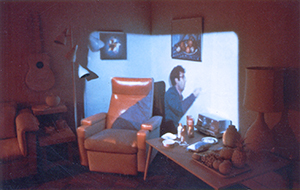
Exhibition: Michael Naimark: Interactive and Immersive Film Environments, 1977 - 1997 (2005)
Curated by Stephen Nowlin.
Displacements 2005 (1980-84); Computer video projection from 16mm film, custom turntable; living room painted white.
Michael Naimark is an experimental film pioneer. He was on the original design team for the MIT Media Laboratory in 1980 and was a founding member of the Atari Research Lab (1982), the Apple Multimedia Lab (1987), and Lucasfilm Interactive (now LucasArts, 1989). The artist’s art projects are in the permanent collections of the American Museum of the Moving Image in New York, the Exploratorium in San Francisco, and the ZKM | Center for Arts and Media in Karlsruhe, Germany. His 3D interactive installation "Be Now Here," produced by Interval with the cooperation of the UNESCO World Heritage Centre, toured in the ZKM's "Future Cinema" exhibition in 2002 and 2003.
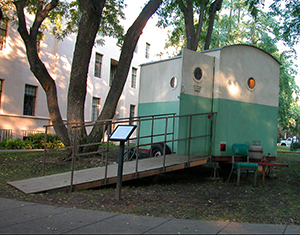
Exhibition: Dr. Crump’s Inductive Geo-Imaging Field Laboratory (Mobile Unit Mk.I) by Michael C. McMillen (2004)
Curated by Stephen Nowlin
Installation view at Caltech Campus: outside view
Michael C. McMillen’s installation at Caltech was one of a three-part collaboration with the Williamson Gallery at ArtCenter College of Design, in which three artists explore the art/science interface. Also at Caltech, artist Lita Albuquerque installed a work called “Stellar Mapping,” and at at the Williamson Gallery artist Steve Roden installed “ear(th),” a sound sculpture engaging geophysical forces in collaboration with Caltech grad student AnnMarie Thomas and geophysicist Mark Simons.
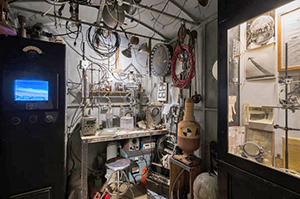
Exhibition: Dr. Crump’s Inductive Geo-Imaging Field Laboratory (Mobile Unit Mk.I) by Michael C. McMillen (2004)
Curated by Stephen Nowlin
Installation view at Caltech Campus: inside view.
The narrative of Dr. Crump's Lab was:
Employing the unique services of an urban archeologist and one-time Caltech student, Dr. C.R. Crump, officials were able to confirm the existence of a tomb-like artifact from the early part of the twentieth century. The object in question is believed to be a subterranean laboratory, sealed and forgotten for nearly 70 years. Using his proprietary technology, Dr. Crump was able to locate the approximate position of the rumored facility and explore the interior with micro cameras.
More info @ The Tenderland Art/History/Science/Music Festival 2004, archived website.
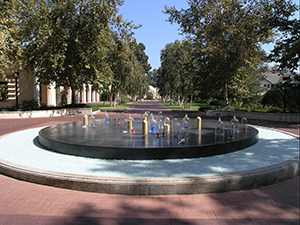
Exhibition: Stellar Mapping by Lita Albuquerque, (2004)
Curated by Stephen Nowlin.
Installation view at Caltech Campus.
Stellar Mapping I was inspired by the Nucleosynthesis Theory which was developed at Caltech and awarded the Nobel Prize in 1983. The installation is both a mapping in the sky of a historical supernovae, and the sculptural interpretation of a fantasy lab researching supernovae. It was on view at Avery Circle, Caltech, for six months.
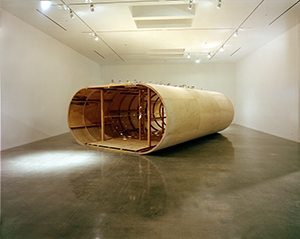
Exhibition: ear(th) by Steve Roden, (2004)
Curated by Stephen Nowlin.
Developed in collaboration with AnnMarie Thomas (Caltech PhD candidate) and Caltech geophysicist Mark Simons.
ear(th) was created by translating data of the effects of the earth's movement during an earthquake, into a score for a sound composition. The same data that generated the interferogram image of the 1999 Landers earthquake, is used as a set of instructions to tell 80 small robots to strike glockenspiel bars of different pitches. ear(th) uses the movement of the earth as a model for the sequence of pitches, and the placement of those pitches within an architectural/sculptural space; allowing the earth, through its suggestions of the spatial and musical order of sound, to become the composer and conductor of a piece of music.
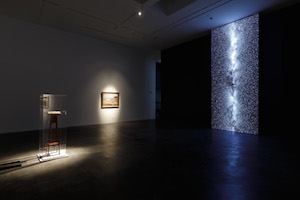
Exhibition: SKY (2020)
Curated by Stephen Nowlin
Left: Nicolaus Copernicus (1473–1543), De revolutionibus
orbium coelestium, 1543; Rare book, 11 x 14.5 in.
Courtesy of Caltech Archives and Special Collections
Middle: Angel Espoy (1879–1963), Monterey Coast,
c. 1930; Oil on canvas, 30 x 40 in.
Courtesy of Jonathan Art Foundation
Right: Gaia Spacecraft, Two Million Stars on the Move, 2017; Milky Way Galaxy data-based projection of five million years of star movement Projected looping video, 3:55, 17 x 7 ft. Courtesy of European Space Agency; ESA/Gaia/DPAC, CC BY-SA 3.0 IGO
Photo: Juan Posada/ArtCenter
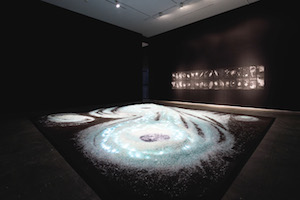
Exhibition: SKY (2020)
Curated by Stephen Nowlin
Carol Saindon, Outside of Inside, 2019
Floor/wall installation: Charcoal drawings, shattered glass, tar paper, 10 x 288 x 230 inches
Courtesy of Scape Gallery, Corona Del Mar
Photo: Juan Posada/ArtCenter
More info and SKY essay @ Dot Magazine.
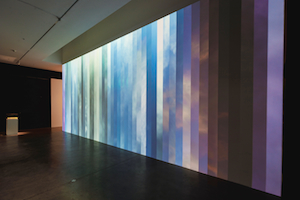
Exhibition: SKY (2020)
Curated by Stephen Nowlin
Rebeca Méndez
Any-Instant-Whatever, 2020
2-channel looping video, captured in Los Angeles in winter 2019–2020 15 x 36 feet, dimensions variable
Courtesy of the artist
Photo: Juan Posada/ArtCenter
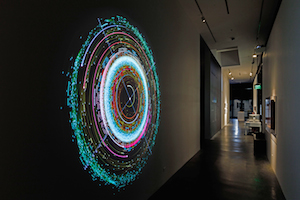
Exhibition: SKY (2020)
Curated by Stephen Nowlin
Eleanor Lutz
Orbit Map of the Solar System, 2019
Rotating wall projection, 96 x 96 in.
Courtesy of the artist and TabletopWhale.com
Photo: Juan Posada/ArtCenter